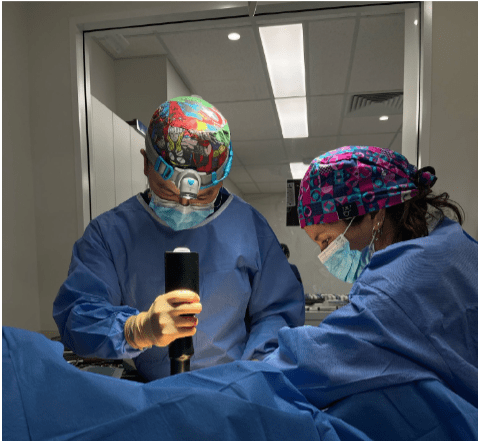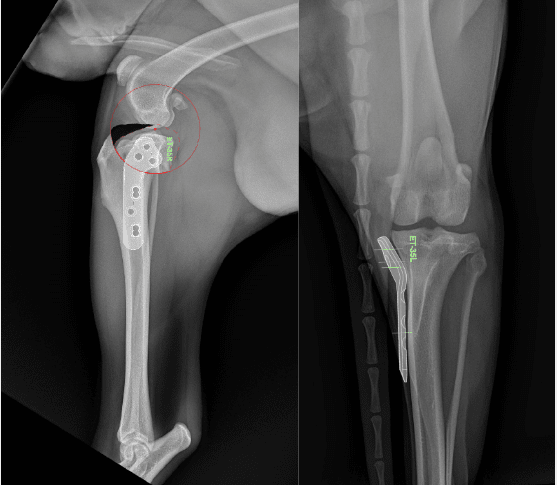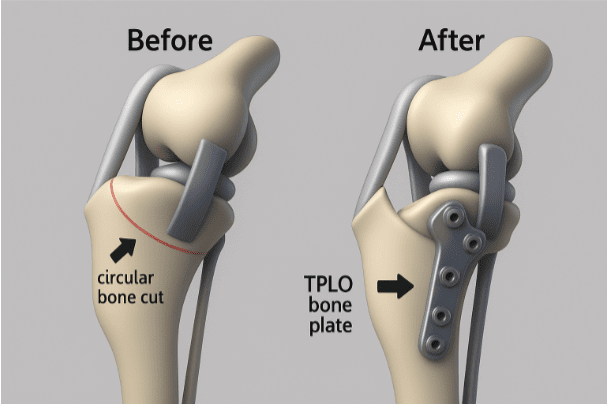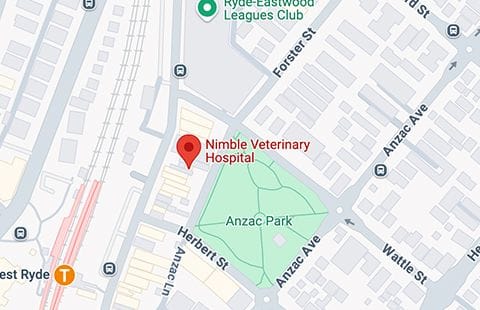Posted in Pet Surgery
Understanding Cranial Cruciate Ligament Disease and TPLO Surgery in Dogs
)
Cranial cruciate ligament (CCL) disease is one of the most common causes of hind limb lameness in dogs. If your dog is limping on a back leg, especially after exercise or during play, they may have torn or ruptured their cranial cruciate ligament, similar to the ACL in
humans.
At Nimble Veterinary Hospital in West Ryde, we frequently diagnose and treat this condition, with TPLO (Tibial Plateau Leveling Osteotomy) surgery being our gold-standard surgical option for stabilising the knee joint and restoring comfort and mobility.
What Is the Cranial Cruciate Ligament?
The cranial cruciate ligament is a key stabiliser in the dog’s stifle (knee) joint. The function of the cranial cruciate ligament is to:
- Prevent over-extension of the knee joint
- Prevent excessive rotation in the knee joint
- Prevent the shin bone (tibia) from sliding forward relative to the thigh bone (femur) during movement, also known as cranial drawer.
When this ligament tears (either partially or completely), dogs often experience:
- Sudden or gradual lameness in a hind leg
- Reluctance to bear weight on the affected limb
- Difficulty rising or jumping
- Muscle wasting over time if left untreated
Unlike in humans, cranial cruciate ligament disease in dogs is usually degenerative, meaning it deteriorates slowly over time until a rupture occurs, sometimes during everyday activity, not necessarily after trauma.
Why TPLO Surgery?
While several surgical techniques exist, TPLO surgery is considered the most reliable option for medium to large breed dogs or highly active pets.
At Nimble Vets, we recommend TPLO in cases where we want to:
- Eliminate joint instability
- Minimise long-term arthritis
- Restore your dog’s comfort and function
- Get them back to their favourite walks sooner
How Does TPLO Work?
TPLO surgery involves making a curved cut in the top of the tibia (shin bone), rotating it to flatten the natural slope, and then securing it in its new position with a bone plate and screws. This change in angle eliminates the need for the cranial cruciate ligament to stabilise the knee during movement.
By stabilising the joint in this way, TPLO allows for better long-term function and reduces pain and inflammation.


What to Expect After TPLO Surgery
At Nimble Veterinary Hospital, we provide thorough post-operative care instructions to ensure your dog’s recovery is as smooth and safe as possible. In the initial stages of the post-operative period, it is recommended to crate rest your dog.
At 6-8 weeks after the procedure, we usually have our patients back for radiographs to check on how the bone is healing and whether there are any concerns with the implants.
Long-Term Prognosis
Most dogs undergoing TPLO surgery return to near-normal function within 3-6 months.
However, ongoing arthritis management is crucial. At Nimble Vets, we often recommend:
- Maintaining a healthy weight
- Joint supplements (e.g. glucosamine, chondroitin)
- Injectable arthritis treatments (Zydax or Synovan)
- Regular check-ups to monitor both knees, as up to 40-60% of dogs will eventually rupture the ligament in the other knee
Potential Complications to Be Aware Of
As with any surgery, there are risks. Complications may include:
- Infection at the surgical site
- Implant issues (loosening or breakage)
- Late meniscal injury (which can require further surgery)
- Ongoing stiffness or arthritis
By carefully following your vet’s aftercare instructions and attending regular rechecks, the risk of complications is significantly reduced.
Think Your Dog Has a Cruciate Ligament Injury?
If you’ve noticed your dog limping or struggling to rise, book an orthopaedic assessment with Dr. Cannon To today.
Nimble Veterinary Hospital
75 Ryedale Road, West Ryde NSW
Call us on 9129 5551
www.nimblevets.com.au
hello@nimblevets.com.au
Let us help your dog get back on their paws.
| Posted in:Client InformationHealth AdvicePet Surgery |
Desexing Your Pet: What You Need to Know
)
As responsible pet owners, ensuring the health and well-being of our furry companions is paramount. One significant aspect of pet care is desexing, a surgical procedure that offers numerous benefits for both pets and their owners. At Nimble Vets, we aim to provide you with detailed information to help you make informed decisions regarding your pet's health.
What is Desexing?
Desexing, also known as neutering or spaying, is a surgical procedure performed by veterinarians to remove an animal's reproductive organs. In males, this involves the removal of the testicles (castration), while in females, it entails the removal of the ovaries and usually the uterus (spaying). This procedure renders the animal incapable of reproducing and can have various health and behavioural benefits.
Health Benefits of Desexing
Desexing is not only a means of controlling the pet population but also offers several health advantages:
For Female Pets:
Prevention of Uterine Infections (Pyometra): Spaying eliminates the risk of pyometra, a potentially life-threatening infection of the uterus.?
Reduced Risk of Mammary Tumours: Spaying before the first heat cycle significantly decreases the risk of mammary gland tumours, which can be malignant in a high percentage of cases.?
Elimination of Ovarian and Uterine Cancers: Removing the ovaries and uterus eliminates the possibility of these cancers developing.?
For Male Pets:
Prevention of Testicular Cancer: Castration removes the risk of testicular cancer, which is common in older, unneutered males.?
Reduced Risk of Prostate Problems: Neutering decreases the likelihood of prostate diseases, including enlargement and infections.?
Lower Incidence of Perianal Tumours: Desexed males have a reduced risk of developing tumours around the anus.?
Behavioural Benefits
Desexing can lead to more manageable and predictable behaviour in pets:
Reduction in Aggression: Neutered males are often less aggressive and less likely to engage in fights with other animals.?
Decreased Roaming Tendencies: Desexed pets are less inclined to roam in search of mates, reducing the risk of accidents and injuries.?
Minimised Spraying and Marking: Neutering can reduce or eliminate the urge to mark territory with urine, particularly in male cats.?
Elimination of Heat Behaviours: Spayed females will not go into heat, avoiding associated behaviours such as yowling and restlessness.
Optimal Timing for Desexing
The appropriate age for desexing varies depending on species, breed, and individual health considerations:
Cats: Generally, kittens can be desexed from around four months of age, before reaching sexual maturity.?
Small to Medium Dogs: Desexing is often recommended between six to nine months of age.?
Large and Giant Breeds: For breeds prone to joint issues, delaying desexing until 12 to 18 months may be advisable to allow for proper growth and development.?
It's essential to consult with your veterinarian to determine the best timing for your pet, taking into account their specific needs and circumstances.
The Desexing Procedure
Desexing is a routine surgical procedure performed under general anaesthesia:
Pre-Surgical Assessment: Your pet will undergo a thorough health check to ensure they are fit for surgery.?
Anaesthesia: Administered to ensure your pet is unconscious and pain-free during the procedure.?
Surgical Removal: The veterinarian will remove the reproductive organs through a small incision.?
Post-Operative Care: After surgery, your pet will be monitored during recovery and provided with pain relief as needed.?
Most pets can return home the same day, with specific instructions for at-home care to ensure a smooth recovery.
Post-Operative Care
Proper aftercare is crucial for your pet's recovery:
Rest and Confinement: Limit your pet's activity for at least 10 to 14 days post-surgery to prevent complications.?
Incision Monitoring: Check the surgical site daily for signs of infection, such as redness, swelling, or discharge.?
Prevent Licking: Use an Elizabethan collar (cone) if necessary to prevent your pet from licking or biting the incision.?
Follow-Up Visits: Attend any scheduled follow-up appointments to ensure proper healing.?
Addressing Common Concerns
Some pet owners have reservations about desexing. Here are responses to common concerns:
Weight Gain: While metabolism may decrease slightly post-desexing, proper diet and exercise can prevent weight gain.?
Personality Changes: Desexing does not alter your pet's fundamental personality but may reduce undesirable behaviours.?
Cost: The cost of desexing is a one-time expense that can prevent costly health issues in the future.?
The Importance of Desexing
Desexing is a responsible choice that contributes to the overall health and longevity of your pet. It also plays a vital role in controlling the pet population, reducing the number of unwanted animals in shelters.
At Nimble Vets, we are committed to providing compassionate and professional care for your pets. If you have any questions or wish to schedule a desexing appointment, please contact us. Together, we can ensure a healthier, happier life for your beloved companion.
| Posted in:Client InformationHealth AdvicePet Surgery |
&geometry(221x100))

